The Effect of Carbonyl and Hydroxyl Compounds Addition on CO2 Injection through Hydrocarbon Extraction Processes
Abstract
1. Introduction
2. Materials and Methods
2.1. Materials
2.2. Procedures
3. Results and Discussion
3.1. Experimental Results
3.2. Extraction Phenomena Due to Co-Solvent
3.3. Co-Solvent Performance Analysis on Assisting CO2 Extraction
4. Conclusions
- Acetone, from the carbonyl group, is classified as a non-associated polar compound with high polarizability and slight possibility to form hydrogen bonds. It assists CO2 to vaporize polar components such as those of polar-aromatic which are dominant in the high carbon numbers of Sample A1. Alkenes and straight-chain alkanes are also slightly removed by CO2-acetone mixture injection. These phenomena are also supported by the properties of acetone which have low cohesion forces and high affinity to interact with other molecules.
- Ethanol, from the hydroxyl group, is classified as a self-associated polar compound. It has roles as both a hydrogen bond acceptor (HBA) and a hydrogen bond donor (HBD) and can assist CO2 to extract the higher-boiling fractions of heavy components, branched-chain alkanes, and slightly polar-aromatic in heavy components, although CO2 and ethanol cannot completely mix together.
- Both acetone and ethanol that have non-polar end in the alkyl group make these co-solvents able to interact with non-polar components and also assist with the CO2 extraction process.
Author Contributions
Funding
Institutional Review Board Statement
Informed Consent Statement
Data Availability Statement
Acknowledgments
Conflicts of Interest
References
- Green, D.W.; Willhite, G.P. Enhanced Oil Recovery; SPE Textbook Series; Society of Petroleum Engineers: Richardson, TX, USA, 1998; Volume 6, p. 1. [Google Scholar]
- Holm, L.W. Miscibility and miscible displacement. J. Pet. Technol. 1986, 38, 817–818. [Google Scholar] [CrossRef]
- Stalkup, F.I. Carbon dioxide miscible flooding: Past, present and outlook for the future. J. Pet. Technol. 1978, 30, 102–106. [Google Scholar] [CrossRef]
- Mungan, N. Carbon dioxide flooding-fundamental. J. Can. Pet. Technol. 1981, 20, 87–92. [Google Scholar] [CrossRef]
- Rudyk, S.; Spirov, P.; Hussain, S. Effect of co-solvents on SC-CO2 extraction of crude oil by consistency test. J. Supercrit. Fluids 2014, 91, 15–23. [Google Scholar] [CrossRef]
- Jӧdecke, M.; Kamps, P.S.; Maurer, G. Experimental investigation of the solubility of CO2 in (acetone + water). J. Chem. Eng. Data 2007, 52, 1003–1009. [Google Scholar] [CrossRef]
- Day, C.Y.; Chang, C.J.; Chen, C.Y. Phase equilibrium of CO2 + ethanol and acetone + CO2 at elevated pressures. J. Chem. Eng. Data 1996, 41, 839–843. [Google Scholar] [CrossRef]
- Liu, J.; Sun, L.; Li, Z.; Wu, Z. Experimental study on reducing CO2-oil minimum miscibility pressure with hydrocarbon agents. Energies 2019, 12, 1975. [Google Scholar] [CrossRef]
- Molecular Polarity. Available online: http://chemistry.elmhurst.edu/vchembook/210polarity.html (accessed on 1 April 2020).
- Handout: Effect of Intermolecular Forces on Boiling Point and Solubility. Available online: https://laney.edu/huisunkim/wp-content/uploads/sites/407/2016/01/Intermolecular-Forces.pdf (accessed on 16 April 2020).
- Fletcher, A.N.; Heller, C.A. Self-association of alcohols in nonpolar solvents. J. Phys. Chem. 1967, 71, 3742–3756. [Google Scholar] [CrossRef]
- Hakim, A.L. Minimum Miscibility Pressure Reduction in CO2 Gas Mixture Injection. Ph.D. Thesis, Institut Teknologi Bandung, Bandung, Indonesia, 13 March 2020. [Google Scholar]
- Rezk, M.G.; Foroozesh, J. Phase behavior and fluid interactions of a CO2-light oil system at high pressures and temperatures. Heliyon 2019, 5, e02057. [Google Scholar] [CrossRef] [PubMed]
- Abdurrahman, M.; Permadi, A.K.; Bae, W.S. An improved method for estimating minimum miscibility pressure through condensation-extraction process under swelling tests. J. Pet. Sci. Eng. 2015, 131, 165–171. [Google Scholar] [CrossRef]
- Rao, D.N. A new technique of vanishing interfacial tension for miscibility determination. Fluid Phase Equilibria 1997, 139, 311–324. [Google Scholar] [CrossRef]
- Abedini, A.; Mosavat, N.; Torabi, F. Determination of minimum miscibility pressure of crude oil-CO2 system by oil swelling/extraction test. Energy Technol. 2014, 2, 431–439. [Google Scholar] [CrossRef]
- Novriansyah, A.; Bae, W.; Park, C.; Permadi, A.K.; Riswati, S.S. Ketone solvent to reduce the minimum miscibility pressure for CO2 flooding at the south Sumatra basin, Indonesia. Processes 2020, 8, 360. [Google Scholar] [CrossRef]
- Rudyk, S.; Hussain, S.; Spirov, P. Supercritical extraction of crude oil by methanol- and ethanol-modified carbon dioxide. J. Supercrit. Fluids 2013, 78, 63–69. [Google Scholar] [CrossRef]
- Hussain, S. Enhanced oil recovery using supercritical carbon dioxide with and without co-solvents. Int. J. Pet. Gas Eng. 2014, 2, 1–12. [Google Scholar]
- McCain, W.D. Petroleum Fluids, 2nd ed.; Pennwell Books: Tulsa, OK, USA, 1990; pp. 1–42. [Google Scholar]
- Li, X.; Du, Y.; Wu, G.; Li, Z.; Li, H.; Sui, H. Solvent extraction for heavy crude oil removal for contaminated soils. Chemosphere 2012, 88, 245–249. [Google Scholar] [CrossRef] [PubMed]
- Brinkley, R.L.; Gupta, R.B. Hydrogen Bonding with Aromatic Rings. AIChE J. 2001, 47, 948–953. [Google Scholar] [CrossRef]
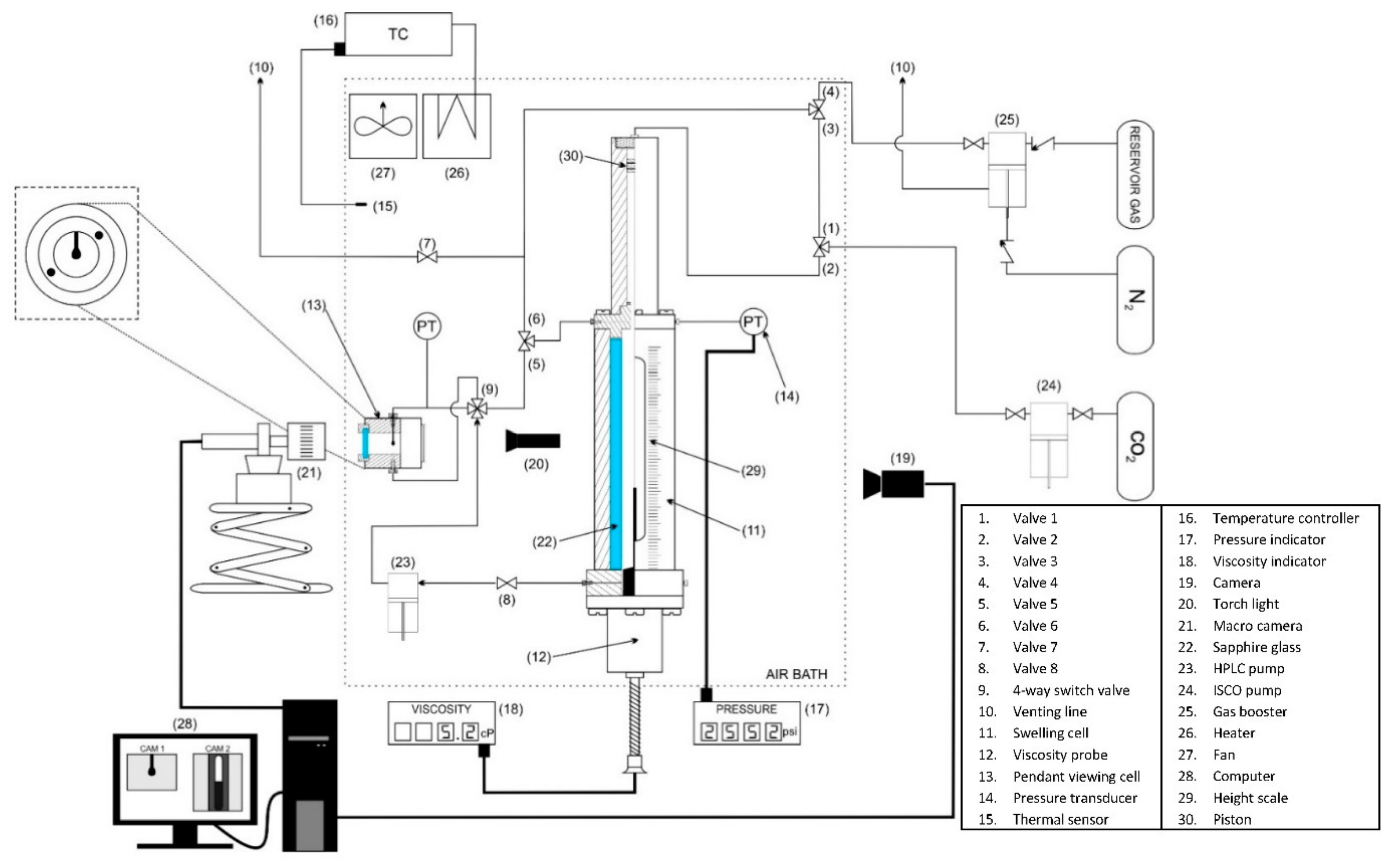
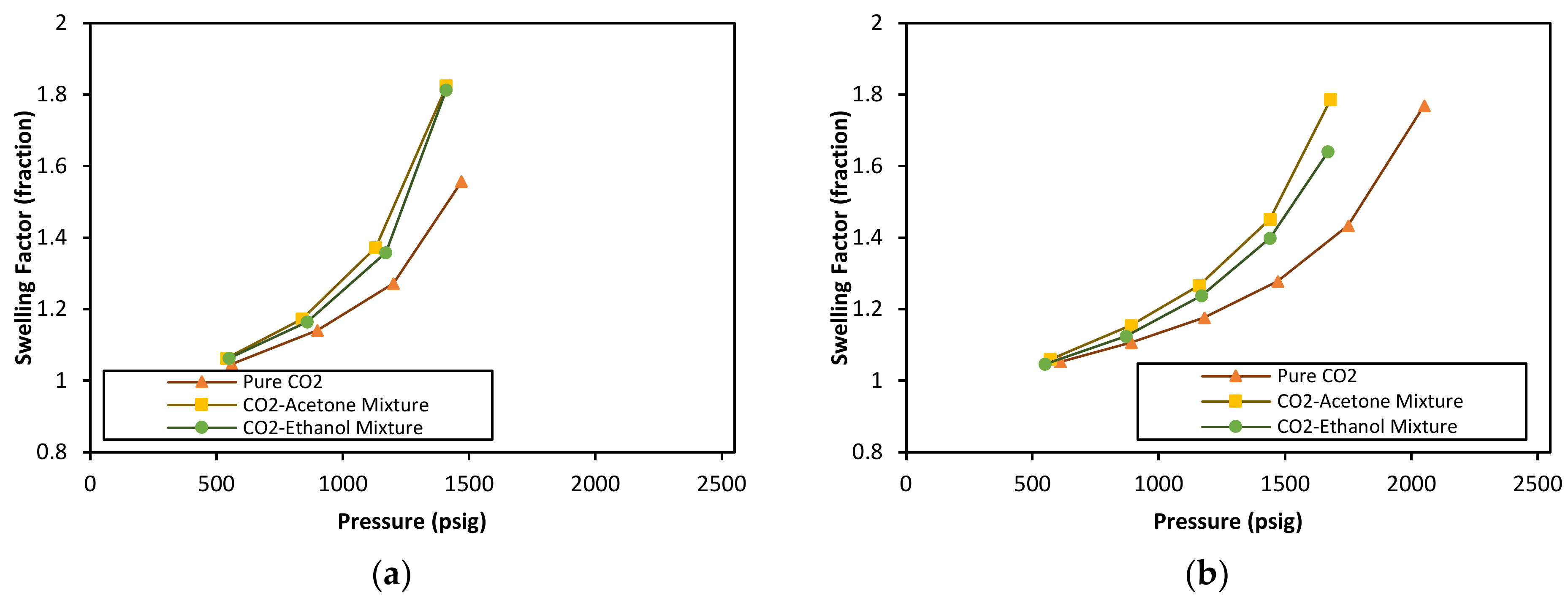


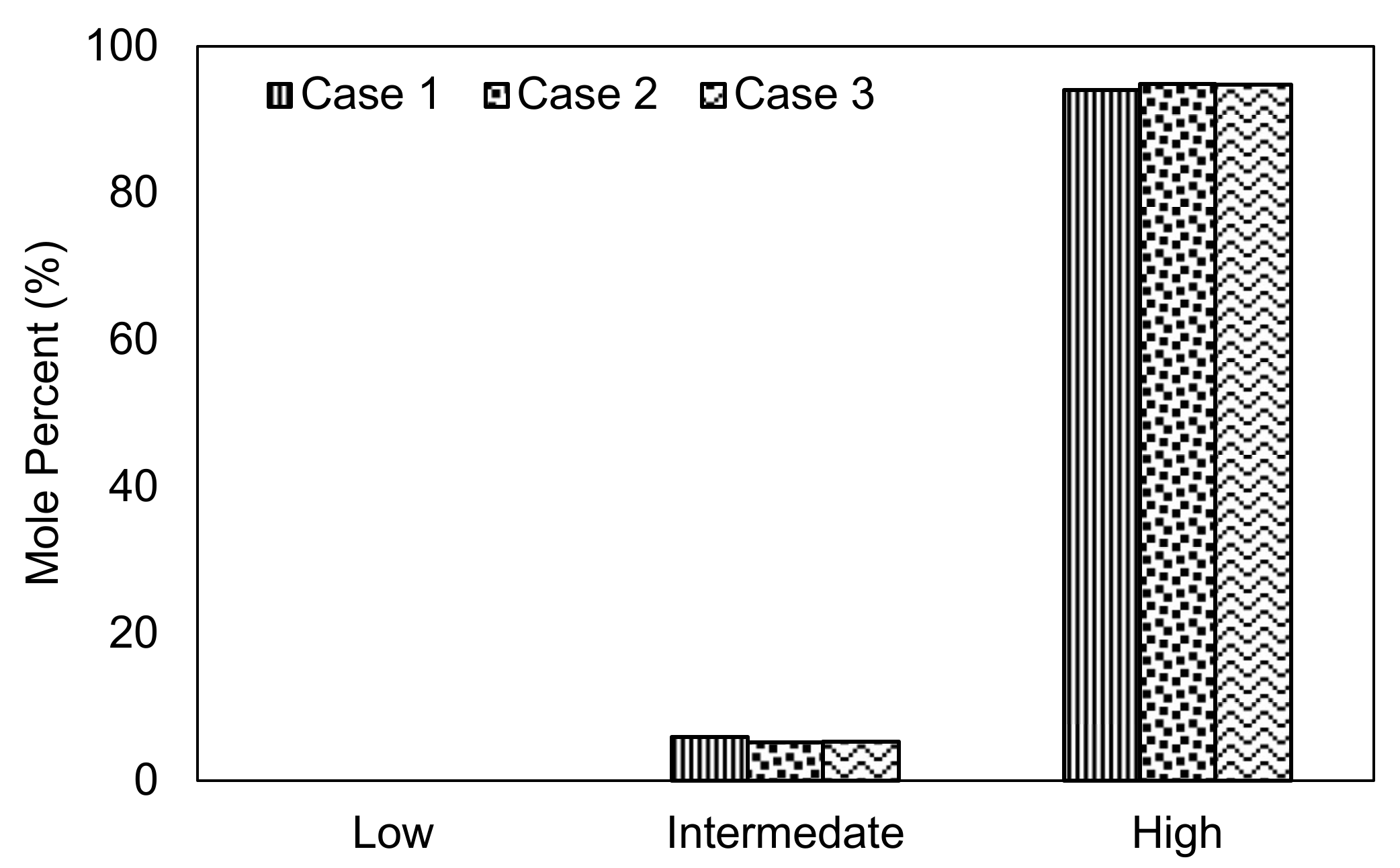
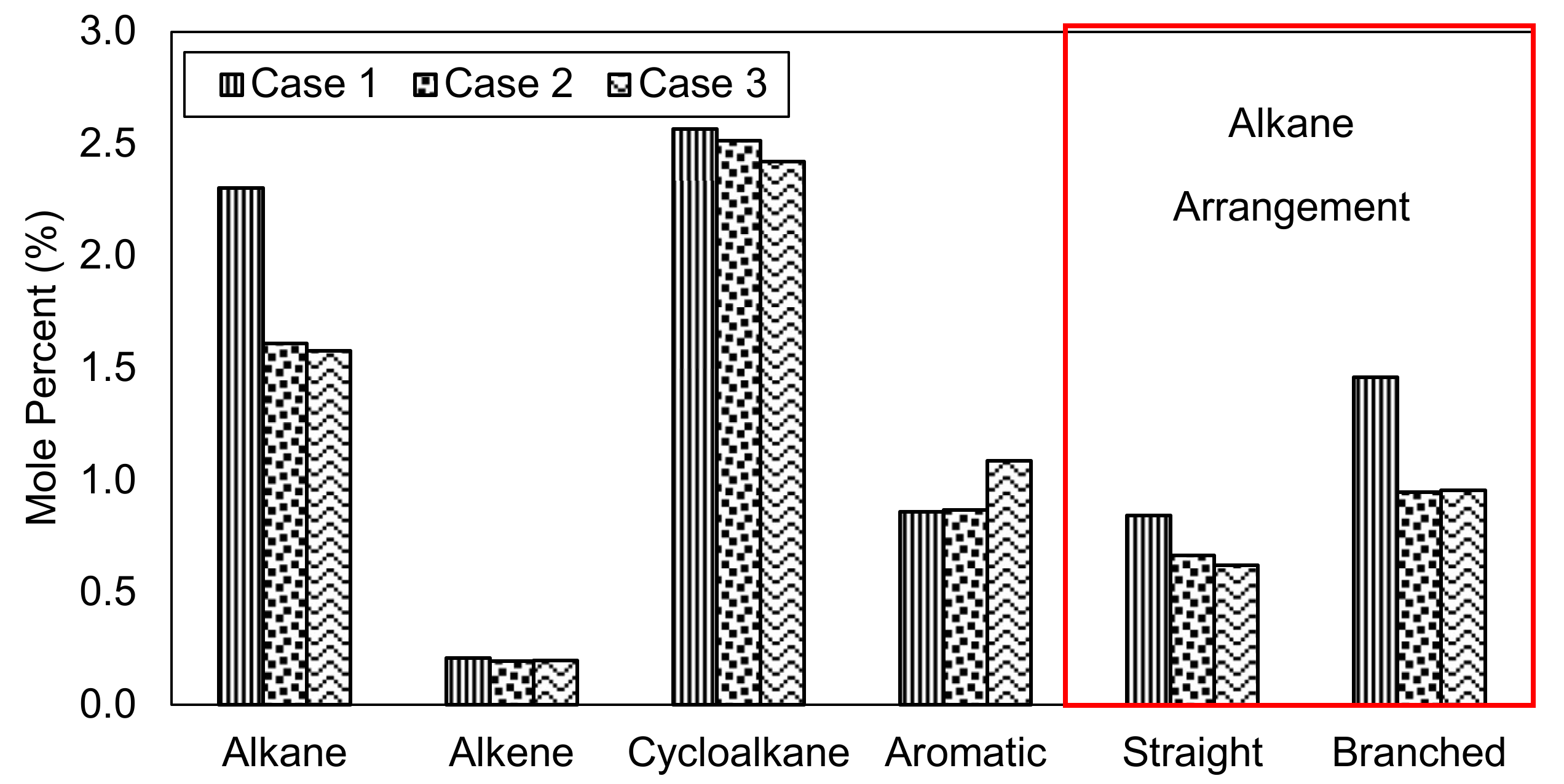
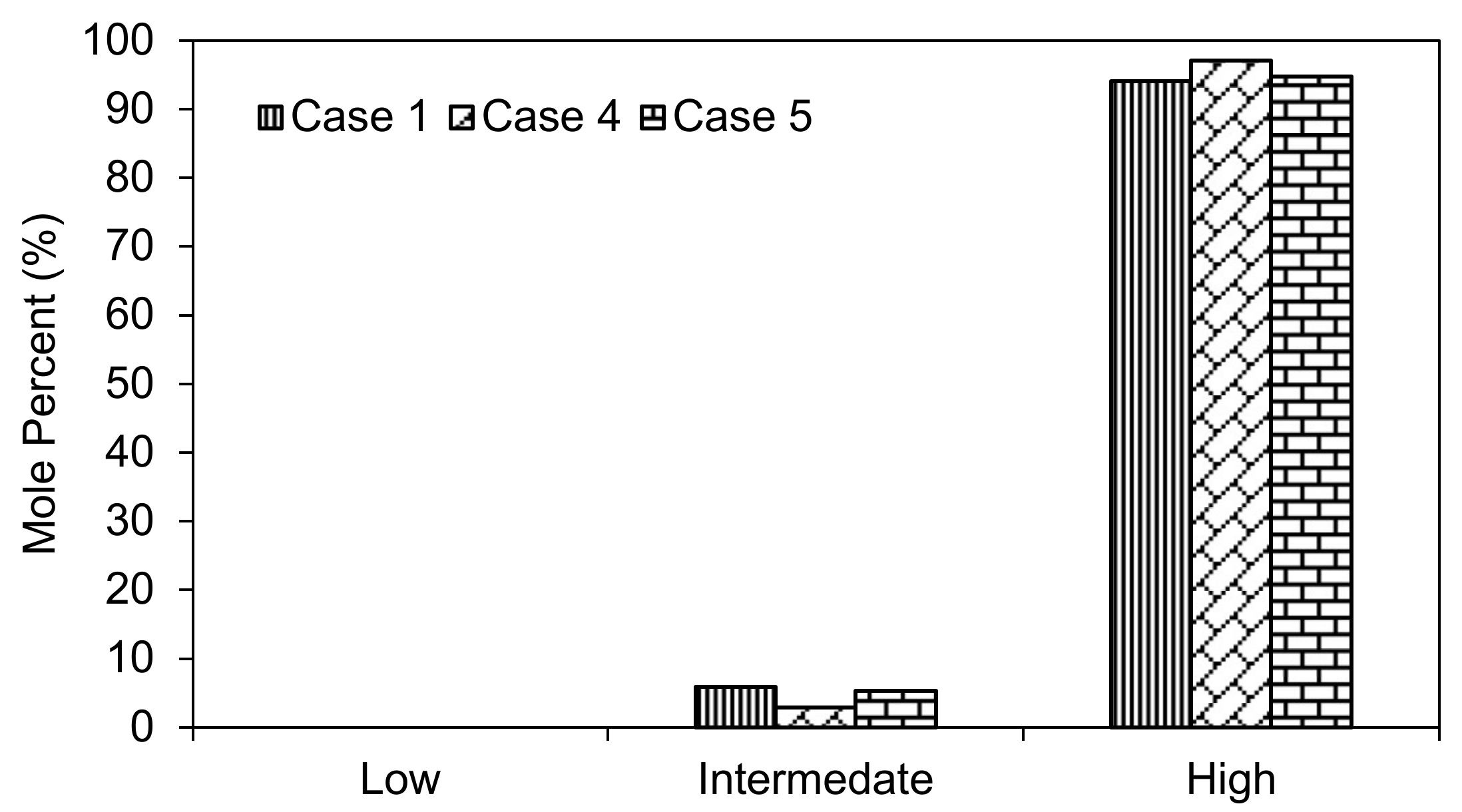
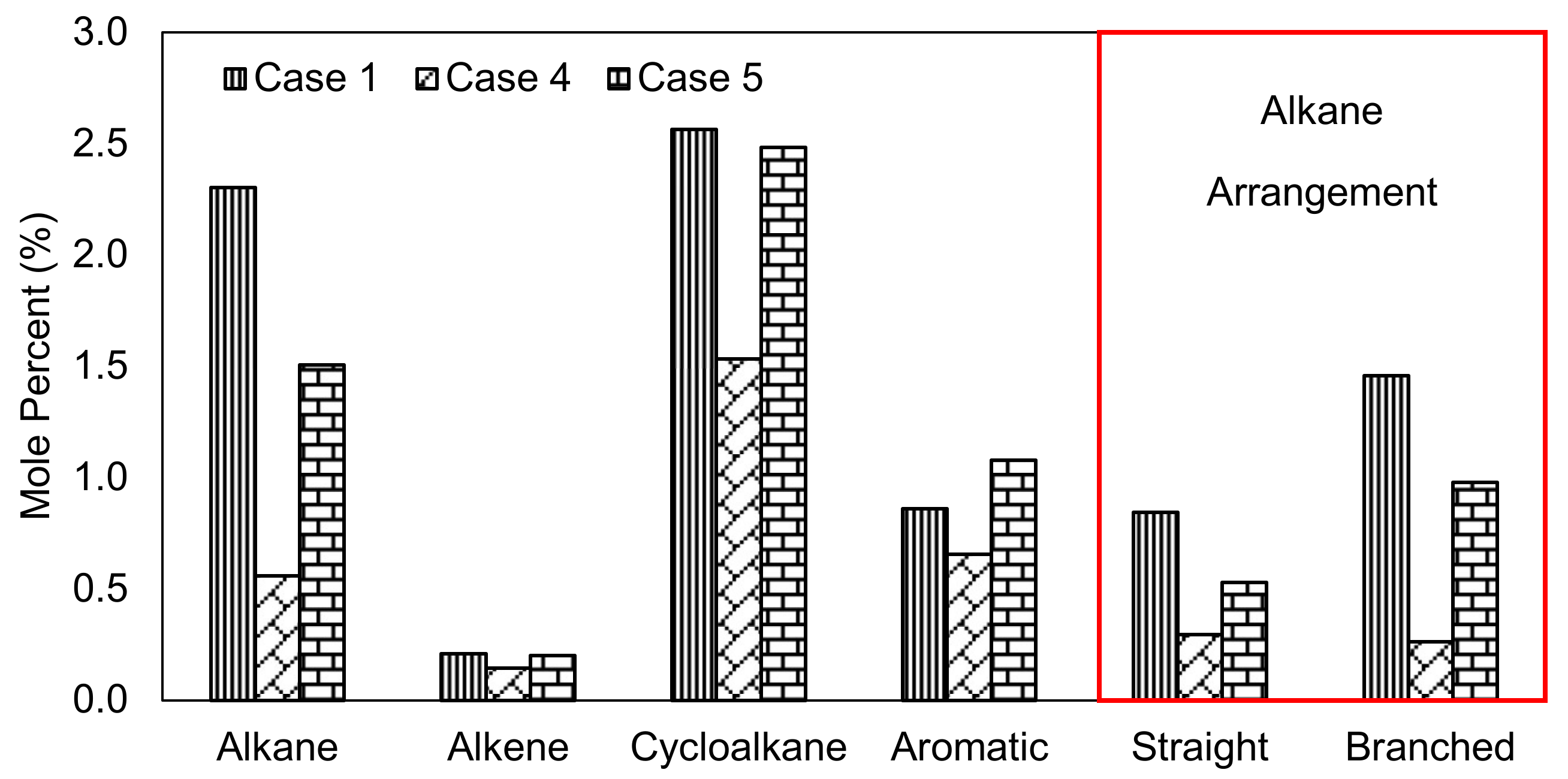
| Properties | A1 |
|---|---|
| API gravity | 42.2 |
| MW C7+ | 135.85 |
| Component | Mole% | |
|---|---|---|
| Sample A1 | ||
| Hydrogen sulfide | H2S | 0 |
| Carbon dioxide | CO2 | 0.06 |
| Nitrogen | N2 | 0.39 |
| Methane | C1 | 13.88 |
| Ethane | C2 | 1.75 |
| Propane | C3 | 4.05 |
| Isobutane | iC4 | 1.65 |
| n-Butane | nC4 | 3.06 |
| Isopentane | iC5 | 1.67 |
| n-Pentane | nC5 | 1.57 |
| Hexane | C6 | 2.7 |
| Heptane plus | C7+ | 69.22 |
| Total | 100 | |
| Parameter | Content (%wt) | |
| Asphaltenes | - | |
| Aromatic | 21.14 | |
| Case | Explanation |
|---|---|
| Case 1 | Original oil (without CO2 injection) |
| Case 2 | Pure CO2 injection at 131 °F |
| Case 3 | CO2-ethanol mixture injection at 131 °F |
| Case 4 | Pure CO2 injection at 158 °F |
| Case 5 | CO2-acetone mixture injection at 158 °F |
| Co-Solvent | π* | α | β |
|---|---|---|---|
| Ethanol | 0.54 | 0.83 | 0.77 |
| Acetone | 0.71 | 0.06 | 0.48 |
Publisher’s Note: MDPI stays neutral with regard to jurisdictional claims in published maps and institutional affiliations. |
© 2020 by the authors. Licensee MDPI, Basel, Switzerland. This article is an open access article distributed under the terms and conditions of the Creative Commons Attribution (CC BY) license (http://creativecommons.org/licenses/by/4.0/).
Share and Cite
Permadi, A.K.; Pratama, E.A.; Hakim, A.L.L.; Widi, A.K.; Abdassah, D. The Effect of Carbonyl and Hydroxyl Compounds Addition on CO2 Injection through Hydrocarbon Extraction Processes. Appl. Sci. 2021, 11, 159. https://doi.org/10.3390/app11010159
Permadi AK, Pratama EA, Hakim ALL, Widi AK, Abdassah D. The Effect of Carbonyl and Hydroxyl Compounds Addition on CO2 Injection through Hydrocarbon Extraction Processes. Applied Sciences. 2021; 11(1):159. https://doi.org/10.3390/app11010159
Chicago/Turabian StylePermadi, Asep Kurnia, Egi Adrian Pratama, Andri Luthfi Lukman Hakim, Alfanda Kurnia Widi, and Doddy Abdassah. 2021. "The Effect of Carbonyl and Hydroxyl Compounds Addition on CO2 Injection through Hydrocarbon Extraction Processes" Applied Sciences 11, no. 1: 159. https://doi.org/10.3390/app11010159
APA StylePermadi, A. K., Pratama, E. A., Hakim, A. L. L., Widi, A. K., & Abdassah, D. (2021). The Effect of Carbonyl and Hydroxyl Compounds Addition on CO2 Injection through Hydrocarbon Extraction Processes. Applied Sciences, 11(1), 159. https://doi.org/10.3390/app11010159





